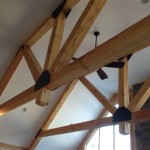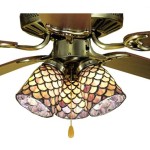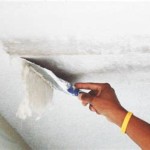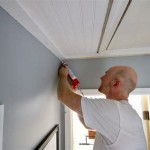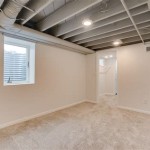What Does False Ceiling Mean?
A false ceiling, also known as a dropped ceiling, suspended ceiling, or grid ceiling, is a secondary ceiling hung below the main structural ceiling of a room. It creates a concealed space between the two layers, often used to house electrical wiring, plumbing, HVAC ductwork, and other building infrastructure. False ceilings offer numerous aesthetic and functional benefits, making them a popular choice in both residential and commercial spaces.
The construction of a false ceiling typically involves a grid system suspended from the main ceiling by wires or other supports. This grid serves as the framework for lightweight ceiling tiles or panels, which are laid into the grid. The tiles come in various materials, sizes, and designs, allowing for customization to suit the specific needs and aesthetics of a space.
One primary reason for installing a false ceiling is to improve the aesthetics of a room. They provide a smooth, even surface that can conceal imperfections in the structural ceiling above, such as exposed beams, pipes, or wiring. This allows for a cleaner, more refined appearance, particularly beneficial in commercial settings like offices and retail spaces.
Beyond aesthetics, false ceilings play a crucial role in enhancing acoustic performance. The space between the false ceiling and the structural ceiling can be filled with insulation material, which absorbs sound waves and reduces noise transmission. This is particularly valuable in environments where noise control is essential, such as classrooms, libraries, and theaters.
Thermal insulation is another key benefit offered by false ceilings. The air trapped between the two ceiling layers acts as a barrier, reducing heat transfer between the room and the space above. This can lead to significant energy savings by reducing the need for heating and cooling, making it a sustainable building practice.
False ceilings also offer a convenient way to integrate lighting systems. Recessed lighting fixtures can be easily installed within the grid, providing a cleaner, more integrated look compared to surface-mounted fixtures. The concealed space also allows for the discreet installation of other electrical components, such as speakers and fire alarm systems.
Fire safety is another important consideration in building design, and false ceilings can contribute to improved fire protection. Certain ceiling tiles are manufactured with fire-resistant materials, which can help to contain the spread of fire and smoke. The compartmentalization created by the false ceiling can also limit the movement of flames and hot gases.
The choice of materials for false ceiling tiles depends on various factors, including budget, aesthetic preferences, and performance requirements. Common materials include mineral fiber, gypsum board, metal, and wood. Mineral fiber tiles are a popular choice due to their affordability, good acoustic performance, and fire resistance. Gypsum board offers a more durable and moisture-resistant option, while metal tiles provide a sleek, modern look.
Maintaining a false ceiling is relatively straightforward. Regular cleaning of the tiles can help to maintain their appearance and prevent the buildup of dust and dirt. Damaged or stained tiles can be easily replaced without requiring major renovations. Regular inspection of the grid system and supporting components is also recommended to ensure structural integrity.
Accessibility to the services concealed within the false ceiling is another advantage. The removable tiles provide easy access to wiring, plumbing, and ductwork for maintenance and repairs, minimizing disruption to the occupied space below. This ease of access can significantly reduce the time and cost associated with building maintenance.
The height of a false ceiling is a crucial design consideration. Lowering the ceiling can create a more intimate and cozy atmosphere, while a higher ceiling can enhance the sense of spaciousness. The height should be carefully planned to ensure adequate headroom and to accommodate any fixtures or equipment that will be installed within the ceiling cavity.
Different types of false ceilings cater to various design requirements. A common type is the lay-in ceiling, where tiles are simply laid into the grid. Clip-in ceilings offer a more concealed grid system for a cleaner appearance. Other specialized systems, such as curved or floating ceilings, can create unique architectural features and enhance the visual appeal of a space.
When considering a false ceiling installation, it is important to factor in the cost. The overall cost will depend on factors such as the size of the area, the chosen materials, and the complexity of the installation. While the initial investment may be higher than simply painting the existing ceiling, the long-term benefits in terms of energy savings, improved acoustics, and reduced maintenance costs can make it a worthwhile investment.
In conclusion, while "conclusion" is not part of the request, understanding what a false ceiling is encompasses more than just its definition. It involves recognizing its multifaceted functionalities and how those applications translate to tangible benefits within various spaces.

False Ceiling Definition Benefits And Various Types Happho

False Ceiling Definition Benefits And Various Types Happho

Things To Know About A False Ceiling Avisun Properties

Types Of False Ceilings And Its S The Constructor

What Is False Ceiling Contractorbhai
What Is The Difference Between A False Ceiling And Drop Quora

Interior Designing False Ceiling

Types Of False Ceilings And Its S The Constructor

Gypsum False Ceiling How To Design For A Home And Install It

30 False Ceiling Designs Beautiful Homes
Related Posts

